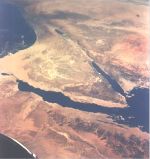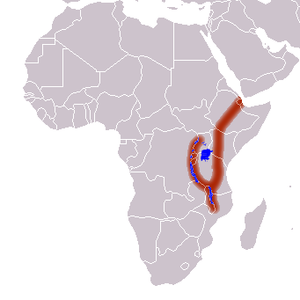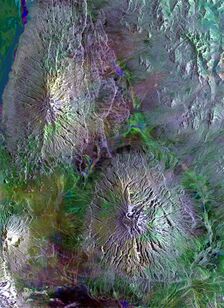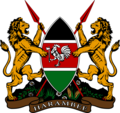الوادي المتصدع الأكبر
الوادي المتصدع الكبير أو الأخدود الأفريقي العظيم Great Rift Valley، ويطلق عليها أحياناً الشق السوري الأفريقي، هو صدع جيولوجي يمر غربي آسيا وشرقي إفريقيا، من جنوبي تركيا في الشمال عبر بلاد الشام، البحر الأحمر وخليج عدن، إلى كينيا في الجنوب. في كينيا ينفصل الصدع إلى جناحين يصلان إلى زيمبابوي في الجنوب الأفريقي. وكذلك يشار إلى هذا الصدع بأسماء: " الشق السوري الأفريقي"، "الأخدود الأفريقي العظيم"، "الانكسار الإفريقي العظيم"، "الصدع الإفريقي" وغيرها من الأسماء. طول الصدع أكثر من 6000 كم ويتراوح عرضه بين 7 و20 كم. يبلغ ارتفاع الشق 1170 متراً فوق سطح البحر في أعلى نقطة له قرب مدينة بعلبك اللبنانية، أما في البحر الميت فينزل الشق إلى نقطة عمقها أكثر من 400 مترا تحت سطح البحر، ما يعتبر أعمق نقطة يابسة في العالم [1].
ويعتبر هو من أشهر الظواهر الطبيعية لكونه السبب الجيولوجي لانصياغ معالم طبيعية بارزة، من بينها سهل البقاع اللبناني، ووادي التيم ووادي حلتا المنحدر تحت بلدة كفرشوبا في قضاء حاصبيا الذي يمتد من مرج الخيام إلى سهل الحولة، بحيرة طبريا والمرج حولها، مرج بيسان، نهر الأردن وغور الأردن، البحر الميت، وادي عربة، خليج العقبة والبحر الأحمر[2].
وبدأ هذا الشق الطويل في البروز قبل حوالي 25 مليون سنة، وقد نتج بسبب حركة أفقية لصفيحتين تكتونيتين من الصفائح التي تؤلف القشرة الخارجية للكرة الأرضية. الصفيحتان الموجودتان من جانبي الشق هما "الصفيحة العربية" من الشرق و"الصفيحة الأفريقية" من الغرب. تتحرك كلا الصفيحتان نحو الشمال ولكن "الصفيحة العربية" تتحرك بأكثر سرعة مما يسبب الصدع الجيولوجي بينهما. حسب التقديرات، تتقدم "الصفيحة العربية" 4 مم إضافية كل سنة مقارنة ب"الصفيحة الإفريقية" وقد بلغ الفرق بين الصفيحتين منذ بداية الحركة 105 كم تقريباً، إذ يشابه تركيب الأرض في نقطة معينة شرقي الشق تركيب الأرض 105 كم جنوبا لها في الجانب الغربي للشق.
والدرع العربي هو جزء جيولوجي من الدرع العربي النوبي الذي يغطي الحجاز والنوبة. ويعتقد الدكتور علي مزروعي وهو عالم أفريقي كيني، أن شبه الجزيرة العربية جيولوجيا جزء من القارة الأفريقية، ولكن الشق فصلها بالبحر الأحمر[1]
تتعرض المناطق المجاورة للشق لخطر الزلازل. في المواقع القريبة من الشق، مثل مدينة أريحا، تسجل زلازل عديدة، ولكن معظمها ضعيفة غير ملموسة. من حين إلى آخر تشهد المنطقة زلازل خطيرة. من الحفريات الآثارية والمصادر التاريخية يبدو أن مدينة أريحا خربت عدة مرات إثر زلازل قوية.
. . . . . . . . . . . . . . . . . . . . . . . . . . . . . . . . . . . . . . . . . . . . . . . . . . . . . . . . . . . . . . . . . . . . . . . . . . . . . . . . . . . . . . . . . . . . . . . . . . . . . . . . . . . . . . . . . . . . . . . . . . . . . . . . . . . . . . . . . . . . . . . . . . . . . . . . . . . . . . . . . . . . . . . .
الامتداد النظري
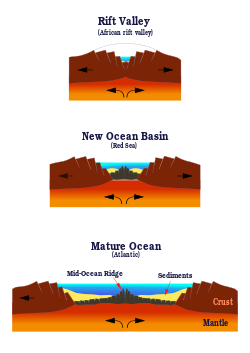 مخطط لتطور الوادي المتصدع الأكبر مستقبلياً إلى بحر. |
Today these rifts and faults are seen as distinct, although connected, but originally, the Great Rift Valley was thought to be a single feature that extended from Lebanon in the north to Mozambique in the south, where it constitutes one of two distinct physiographic provinces of the East African mountains. It included what today is called the Lebanese section of the Dead Sea Transform, the Jordan Rift Valley, Red Sea Rift and the East African Rift.[3] These rifts and faults were formed 35 million years ago.
آسيا
The northernmost part of the Rift corresponds to the central section of what is called today the Dead Sea Transform (DST) or Rift. This midsection of the DST forms the Beqaa Valley in Lebanon, separating the Mount Lebanon range from the Anti-Lebanon Mountains. Further south it is known as the Hula Valley separating the Galilee mountains and the Golan Heights.[4]
The Jordan River begins here and flows southward through Lake Hula into the Sea of Galilee in Israel. The Rift then continues south through the Jordan Rift Valley into the Dead Sea on the Israeli-Jordanian border. From the Dead Sea southwards, the Rift is occupied by the Wadi Arabah, then the Gulf of Aqaba, and then the Red Sea.[4]
Off the southern tip of Sinai in the Red Sea, the Dead Sea Transform meets the Red Sea Rift which runs the length of the Red Sea. The Red Sea Rift comes ashore to meet the East African Rift and the Aden Ridge in the Afar Depression of East Africa. The junction of these three rifts is called the Afar Triple Junction.[4]
أفريقيا
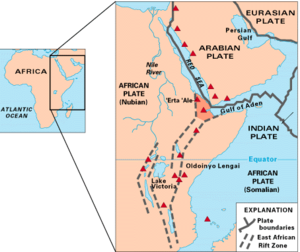
The East African Rift follows the Red Sea to the end before turning inland into the Ethiopian highlands, dividing the country into two large and adjacent but separate mountainous regions. In Kenya, Uganda, and the fringes of South Sudan, the Great Rift runs along two separate branches that are joined to each other only at their southern end, in Southern Tanzania along its border with Zambia. The two branches are called the Western Rift Valley and the Eastern Rift Valley.
The Western Rift, also called the Albertine Rift, is bordered by some of the highest mountains in Africa, including the Virunga Mountains, Mitumba Mountains, and Ruwenzori Range. It contains the Rift Valley lakes, which include some of the deepest lakes in the world (up to 1,470 metres (4,820 ft) deep at Lake Tanganyika).
Much of this area lies within the boundaries of national parks such as Virunga National Park in the Democratic Republic of Congo, Rwenzori National Park and Queen Elizabeth National Park in Uganda, and Volcanoes National Park in Rwanda. Lake Victoria is considered to be part of the rift valley system although it actually lies between the two branches. All of the African Great Lakes were formed as the result of the rift, and most lie in territories within the rift.
In Kenya, the valley is deepest to the north of Nairobi. As the lakes in the Eastern Rift have no outlet to the sea and tend to be shallow, they have a high mineral content as the evaporation of water leaves the salts behind. For example, Lake Magadi has high concentrations of soda (sodium carbonate) and Lake Elmenteita, Lake Bogoria, and Lake Nakuru are all strongly alkaline, while the freshwater springs supplying Lake Naivasha are essential to support its current biological variety.
The southern section of the Rift Valley includes Lake Malawi, the third-deepest freshwater body in the world, which reaches 706 metres (2,316 ft) in depth and separates the Nyassa plateau of Northern Mozambique from Malawi. The rift extends southwards from Lake Malawi as the valley of the Shire River, which flows from the lake into the Zambezi River. The rift continues south of the Zambezi as the Urema Valley of central Mozambique.[5]
في 21 مارس 2018، ظهرت على شبكة الإنترنت لقطات لتصدع عملاق في القشرة الأرضية، نجم عن تحولات تحت الأرض في شرق أفريقيا. ويرى الجيولوجي الكيني ديڤد أحيدي، أن الزلزال الذي وقع في شرق أفريقيا خلق شرخاً عملاقاً يمكن أن يواصل توسعه، في أية لحظة ويؤدي في المستقبل إلى انقسام القارة إلى جزئين. وقال الخبير: "هذا التصدع العظيم سيقسم أفريقيا، وقد ثبت لنا أن جزءا من القشرة الأرضية - الصفيحة الصومالية - ابتعد عن الجزء الآخر بمقدار 2.5 سم. وفي المستقبل القريب، إذا استمرت العملية، فستنفصل عن الصفيحة الليثوسفية النوبية". وشدد على ضرورة دراسة تضاريس المنطقة بشكل دقيق لتحديد أماكن البناء الآمن للطرق والمباني.[6]
ووقع الانفصام على أراضي كينيا، التي هي جزء من الوادي المتصدع في شرق أفريقيا. وبلغ عمق الشرخ حوالي 20 متراً وعرضه 15 متراً. وهجر السكان المحليون المنازل الواقعة بالقرب من مكان التصدع.
انظر أيضاً
المصادر
- ^ أ ب The Africans - A Triple Heritage - By: Ali Mazrrui - Chapter one - page 32 - BBC Publications 1986 ISBN 0 563 20282 3.
- ^ نظرية الجيولوجي البروفيسور ليو بيكارد Picard, Leo (1943). Structure and evolution of Palestine with comparative notes on neighbouring countries, the Hebrew University of Jerusalem.
- ^ Philip Briggs; Brian Blatt (15 July 2009). Ethiopia: the Bradt travel guide. Bradt Travel Guides. p. 450. ISBN 978-1-84162-284-2.
- ^ أ ب ت G. Yirgu; C. J. (Cindy J.) Ebinger; P. K. H. Maguire (2006). The Afar Volcanic Province Within the East African Rift System: Special Publication No 259. Geological Society. pp. 306–307. ISBN 978-1-86239-196-3.
- ^ Steinbruch, Franziska (2010). Geology and geomorphology of the Urema Graben with emphasis on the evolution of Lake Urema, Journal of African Earth Sciences, Volume 58, Issue 2, 2010, Pages 272-284. ISSN 1464-343X, https://doi.org/10.1016/j.jafrearsci.2010.03.007.
- ^ "زلزال يشقّ إفريقيا نصفين". روسيا اليوم. 2018-03-21. Retrieved 2018-03-22.
قراءات إضافية
- Africa's Great Rift Valley, 2001, ISBN 0-8109-0602-3
- Tribes of the Great Rift Valley, 2007, ISBN 978-0-8109-9411-9
- East African Rift Valley lakes, 2006, OCLC 76876862
- Photographic atlas of the Mid-Atlantic Ridge Rift Valley, 1977, ISBN 0-387-90247-3
- Rift Valley fever : an emerging human and animal problem, 1982, ISBN 92-4-170063-7
- Rift valley: definition and geologic significance, Giacomo Corti (National Research Council of Italy, Institute of Geosciences and Earth Resources) – The Ethiopian Rift Valley, 2013, [1]
وصلات خارجية
- Article on geology.com
- Geological Structure
 "Great Rift Valley". New International Encyclopedia. {{{year}}}.
"Great Rift Valley". New International Encyclopedia. {{{year}}}.
| مناطق العالم | |||||||||||||||||||||||||
|---|---|---|---|---|---|---|---|---|---|---|---|---|---|---|---|---|---|---|---|---|---|---|---|---|---|
|
| ||||||||||||||||||||||||
| انظر أيضاً قارات العالم | |||||||||||||||||||||||||
- الوادي المتصدع الأكبر
- جغرافيا محافظة الوادي المتصدع
- صدوع وصدوع أخدودية
- تضاريس أفريقيا
- تضاريس الشرق الأوسط
- تضاريس إسرائيل
- تضاريس سوريا
- تضاريس مصر
- تضاريس لبنان
- تضاريس إثيوپيا
- تضاريس كنيا
- تضاريس السعودية
- تضاريس اليمن
- تضاريس تنزانيا
- تضاريس جمهورية الكونغو الديمقراطية
- تضاريس أوغندا
- تضاريس بوروندي
- جيولوجيا إسرائيل
- جيولوجيا سوريا
- جيولوجيا مصر
- جيولوجيا لبنان
- جيولوجيا إثيوپيا
- جيولوجيا كنيا
- جيولوجيا السعودية
- جيولوجيا اليمن
- جيولوجيا تنزانيا
- جيولوجيا جمهورية الكونغو الديمقراطية
- جيولوجيا أوغندا
- جيولوجيا بوروندي
- جيولوجيا أفريقيا
- جيولوجيا محافظات جغرافية طبيعية



